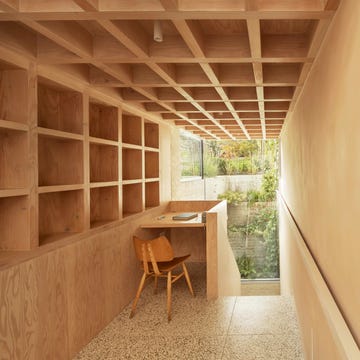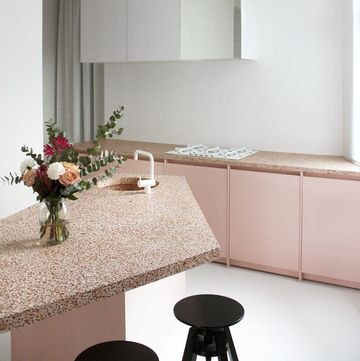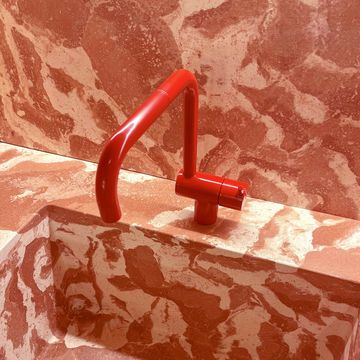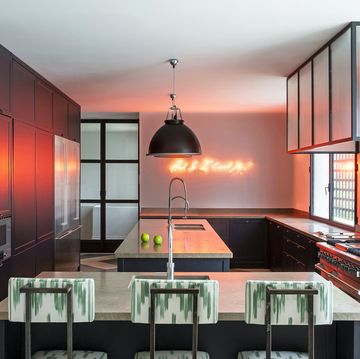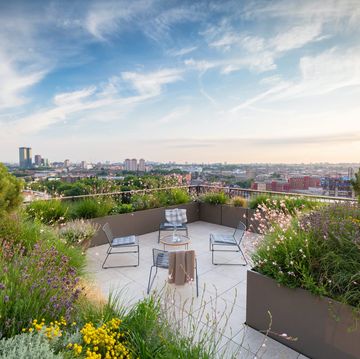Launched in 2016, Kate Guinness Design specialises in timeless interiors awash with vibrant hues and pattern. Guinness works between her Notting Hill studio and Wiltshire, and is strongly influenced by her childhood in Ireland, where she was surrounded by Georgian country houses.
What’s her inspiration? After an interior design course at London’s KLC School of Design, Guinness studied theatre design, which has had a lasting influence on her work. ‘I learnt about the importance of light in a room, both natural and artificial, and how to create atmosphere,’ she says. ‘It also made me think about volumes as the basis for decoration.’
Guinness cut her teeth working for legendary London decorator Jane Ormsby Gore, then with designer Adam Bray. She now works mostly on residential projects and has launched her own homewares line, with tables inspired by Georgian-Irish furniture made with sustainably-sourced wood.
What’s her style? Guinness puts a modern spin on eclectic country-house décor. She says the most important thing is for her designs ‘to feel like home and appear to have grown organically. We create interiors with an authentic sense of accumulation, juxtaposing contemporary art and vintage textiles with antique and mid-century furniture. It results in projects that feel lived in rather than styled.’
What's everyone reading?
Creative inspirations include the 20th-century Spanish decorator Jaime Parladé. ‘He had an amazing sense of colour and created beautifully comfortable, layered rooms,’ Guinness enthuses. ‘The brave use of colour in Irish-Georgian houses has also had a huge impact on my palette.’
What are her recent projects? The studio has recently completed work on a five-storey London townhouse. ‘We had to make it fit for purpose while remaining sensitive to the original design,’ says Guinness. ‘The client was bold in his choices, giving us the freedom to create a rich colour palette.’
Elsewhere, she’s designed The Elder Press Cafe in Hammersmith, a calm yet bright space. ‘We’d previously worked with the owner, chef Lindsay Elder, so we knew her taste well,’ she explains. ‘We wanted to create a space that would reflect her personality as well as giving a nod to the history of the area. It’s a home from home for the local community.’
What is she currently working on? As well as the revamp of a large Kensington family home, Guinness is also doing a challenging project for herself, the conversion of an old stable block. ‘It had half fallen down, so we’re rebuilding part from scratch, converting the other section and joining the two,’ she reveals.
She says: ‘We take a collaborative approach and make bold decisions that emphasise rather than overwhelm historical detail, while also allowing the client’s taste to shine through.’ kateguinness.co.uk
Expert advice
Kate Guinness’s tips on using colour and pattern with confidence
1 Draw colour inspiration from outside the home, choosing shades that make the indoor and outdoor spaces feel joined. The mood and usage of the room plays a large part: for example, in a bedroom, greens work particularly well to create a restful feel.
2 Painting floorboards with patterns can jazz up existing floors. For one recent project, we painted old pine boards in a bathroom in a checkerboard design: white diamonds contrasting with the natural timber. You can also use colourful painted details as an alternative to mouldings. It’s simple yet impressive.
3 Try starting a scheme from a single fabric. Upholstery is such an investment that it’s essential to get it right. Adding a border to curtains or blinds injects interest, while using contrasting fabric for the lining makes them a feature from the outside as well as inside.
4 Think outside of the box when it comes to upholstery. Chairs and sofas can have contrasting backs or cushions. This not only adds character, but can help use up vintage remnants where you might not have enough to cover the entire piece of furniture. A large-scale pattern on a small piece, such as a stool, can have a dramatic impact.








